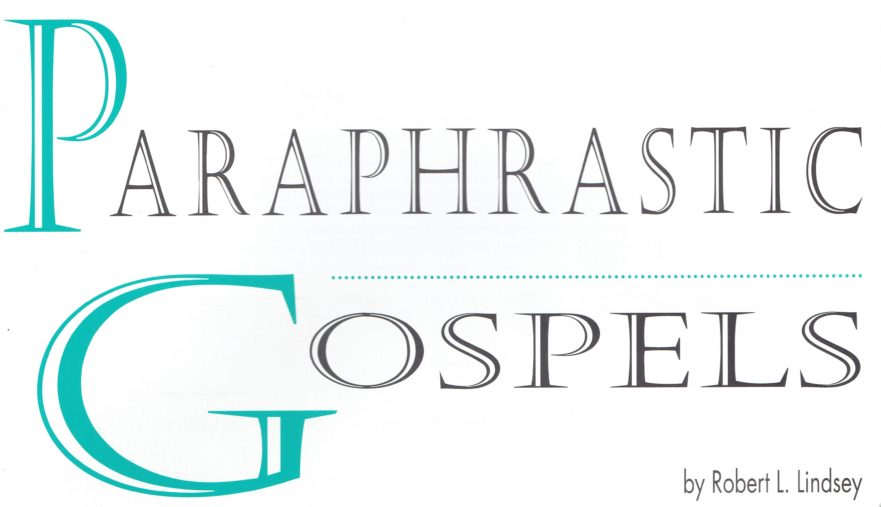
The four Evangelists of the Greek New Testament, though concurring at many points, demonstrate a remarkable degree of disparity when retelling their versions of the life of Jesus. This is especially true of Mark and John.[1] Their accounts are very early Greek paraphrases of the gospel records.[2] Mark’s Gospel predates John’s by about forty years, and it will be the Markan paraphrastic method that will occupy our attention here.
When reading Matthew, Mark and Luke in modern translation, a reader generally cannot see the differences in wording of the underlying Greek texts. This is because the differences are often synonymic. If perceptible at all, they can easily escape notice. In scores of places, where Luke used a certain word or phrase, Mark used an equivalent, but different word or phrase. The best way to grasp how Mark operates is to look at examples from the Gospels themselves.
Markan Synonyms
In Matthew 9:1-8, Mark 2:1-12 and Luke 5:17-26, there is a story about a paralytic who is carried to Jesus on some sort of stretcher. Matthew and Luke agree against Mark that the paralytic was carried on a κλίνη (kline).[3] Mark has chosen κράβαττος (krabattos) as a synonym.[4] The variance is reflected in the New American Standard Bible. Kline is translated as “bed” and krabattos as “pallet.”
Paid Content
Premium Members and Friends of JP must be logged in to access this content: Login
If you do not have a paid subscription, please consider registering as a Premium Member starting at $10/month (paid monthly) or only $5/month (paid annually): Register
One Time Purchase Rather Than Membership
Rather than purchasing a membership subscription, you may purchase access to this single page for $1.99 USD. To purchase access we strongly encourage users to first register for a free account with JP (Register), which will make the process of accessing your purchase much simpler. Once you have registered you may login and purchase access to this page at this link:
Editors’ note: Out of esteem for our teacher, Robert Lindsey, we have collaborated to make this article and his “Unlocking the Synoptic Problem: Four Keys for Better Understanding Jesus” (Jerusalem Perspective 49 [Oct.-Dec. 1995], 10-17, 38) available to our readers. These articles mark the end of Robert Lindsey’s scholarly career. With his health waning and incapacitated by a series of strokes that accompanied the diabetes from which he suffered, Dr. Lindsey was able to complete only a first or second draft of each article. Though we could not preserve Dr. Lindsey’s writing style, great effort was made to preserve faithfully the content of his articles. We are responsible for the articles’ conclusions and footnotes. — David Bivin and Joseph Frankovic

- [1] A rule of thumb is: Opposite a parallel story in Luke, Mark will change up to fifty percent of Luke’s words; where Matthew has a story parallel to Mark, Matthew will copy about seventy percent of the words found in Mark, but give, against Mark, about ten percent of the words Luke uses; where John has a story parallel to one found in the synoptic tradition, he will have phrases reflecting one or more of the synoptic documents, resulting in a mixing of the words, especially the words of Mark and Luke—less often copying readings from Matthean parallels. ↩
- [2] One helpful way of viewing John’s Gospel is in light of the Book of Deuteronomy. Deuteronomy is a retelling of the Exodus and wilderness experience. It is a theological reflection on the past and a restating of the commandments, to prepare the Israelites for the transition from a nomadic to an agriculturally based, sedentary lifestyle. In particular, certain aspects of the biblical commandments were developed and emphasized to meet new challenges. The Gospel of John is similar. It represents a theological development in the presentation of who Jesus is. Moreover, John’s method is freer than Mark’s. ↩
- [3] Cf. Matt. 9:2 with Luke 5:18, and Matt. 9:6 with Luke 5:24. In Luke 5:24 the word κλινίδιον (klinidion, a little bed), the diminutive of κλίνη (kline), is used. ↩
- [4] Cf. Mark 2:4, 11. ↩


![Robert L. Lindsey [1917-1995]](https://www.jerusalemperspective.com/wp-content/uploads/userphoto/28.jpg)




























































































